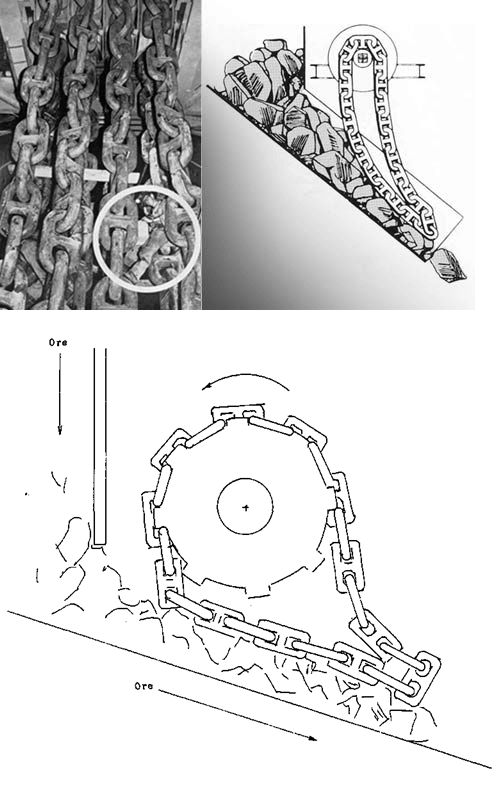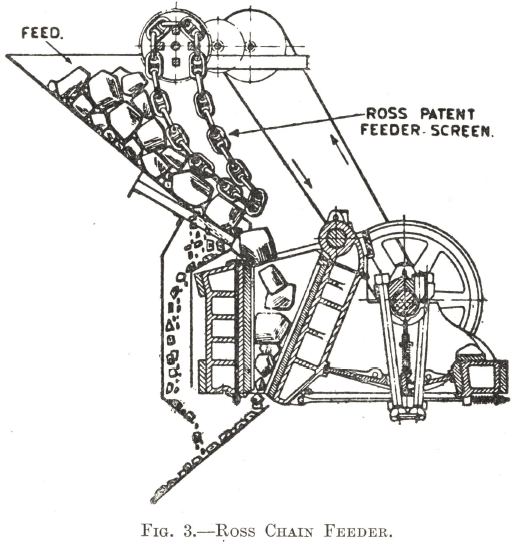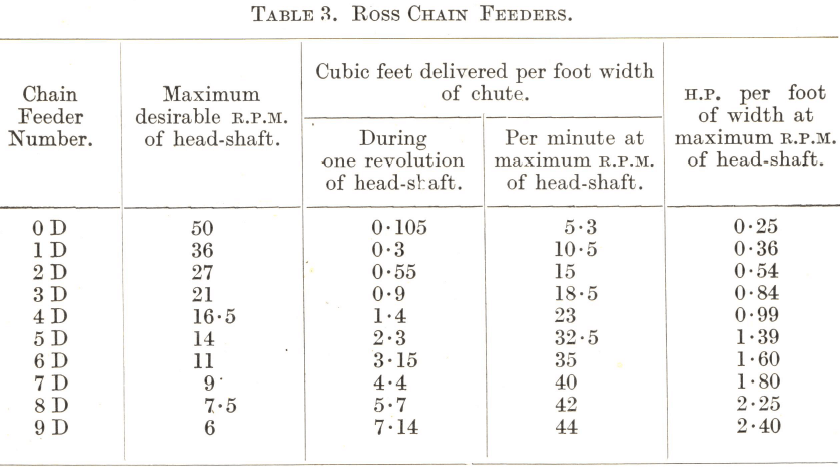A feeder that uses chains to regulate the ore flow in a different manner is the ROSS Chain FEEDER. This feeder uses a series of very large, heavy chain that has been forged into loops. These loops are placed over cogged wheels that are suspended over the ore passage. The free end of the chain loops are hung down onto the rock. The size and the weight of the chain links are sufficient to stop the flow of ore. To keep the ore moving the chains are revolved, dragging the links over the ore will cause it to flow.
A problem common to all (even chain) feeders is the ore size, large ore tends to jam together in what is known as a “HANG UP”. It is called this because it is usually up an ore pass above the equipment, and is just hanging there. To free it often means that the operator will have to either pry it down with a scaling bar or in severe cases it will have to be blasted. Both of these procedures have a certain degree of danger involved. No one should attempt either one without the necessary instruction.
 Large ore poses another problem that is unique to the feeders that use chains for a control. Once the ore reaches a critical size it begins to hang up easier, when it does the open area that is created directly below the hang up allows the rock that formed the hang up to gain velocity when it comes down. The speed of these falling rocks can be great enough to push the chains out of the way allowing more ore than can be handled through.
Large ore poses another problem that is unique to the feeders that use chains for a control. Once the ore reaches a critical size it begins to hang up easier, when it does the open area that is created directly below the hang up allows the rock that formed the hang up to gain velocity when it comes down. The speed of these falling rocks can be great enough to push the chains out of the way allowing more ore than can be handled through.
Very fine ore can present a similar problem, not only to the Ross feeder but many of the other types of coarse ore feeders as well. What happens is the smaller rock will flow unhampered, around, through or over the feeder. Unable to stop the flow, the conveyors or the crushers that the ore is being fed to, will become over loaded.
To control both of these problems, a secondary form of regulating the tonnage may have to be resorted to. This could be a simple sliding gate placed after the original feeder. Or as in many cases, more than one feeder, this allows the operator to shut one down should it “RUNAWAY”. If “runaways” are a problem, provisions will be made in the operating procedure to handle them. Multiple feeders are a method of tonnage control, as is regulating the speed that the Ross feeder chains revolve.
RossChainFeeders

Chain Feeder
The Chain Feeder works on a different principle altogether from the apron feeder. It consists of a curtain of endless steel chains, suspended from and driven by an overhead tumbler, and mounted as a rule in a chute leading out of the bin, as shown in Fig. 3. The size of the bin opening and the slope of the chute must be sufficient to ensure that the ore flows down without any chance of choking or stopping. The motion of the chains as they move with the material Controls the flow of the ore with a regularity comparable with that of an apron feeder. The size of the links of which the chains are composed varies according to the size and character of the feed ; the curtain must be heavy enough to stop the most violent rush of material likely to be encountered. The Chain Feeder may be driven by its own motor, from a line shaft, or from the crusher or conveyor that it serves. Changes in the rate of flow of the ore are obtainable by the introduction of a change speed gear, which is the preferable method for large feeders, or by the use of a chute with a pivoted end, the raising of which decreases the tonnage flow, and vice versa. If such a chute is used for loading skips, trucks, etc., the flow of ore can be cut off sharply when the required amount has been delivered by raising the pivoted end of the chute, which action also switches off the motor driving the feeder.
Not only is the feeder cheap, but it is as simple and fool-proof as any type that is made ; it is almost impossible to damage it, and the wear on the tumbler and chains is negligible. For these reasons it is very suitable for controlling the feed from the coarse ore bin. It is also suitable for regulating the flow of such material on to a belt conveyor, since, however large the lumps, it will give a quiet feed with the minimum amount of damage to the surface of the belt.
The capacity and power requirements of standard sizes of Chain Feeders are given in Table 3, the duties of the feeders listed ranging from small crushed material to the largest power-shovel size.

